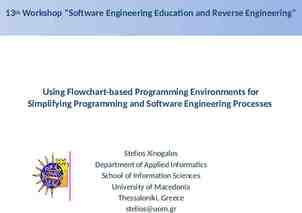Different Modalities in Imaging: An Overview Amy Crane, DVM
32 Slides125.23 KB
Different Modalities in Imaging: An Overview Amy Crane, DVM
In This Lecture Learn when to choose the appropriate modality Understanding the difference between the different modalities available
Basis To You create a radiograph, x-rays are passed through the patient and an image is recorded on a piece of radiographic film. have all seen them, and we will go into painful detail on this in future lectures.
Best For Screening test Inexpensive (eg: 80 – 150.00 for 2 views) No need (in general) for sedation or anesthesia Non-painful Able to look at whole body systems at once the most information about areas that are Give similar in appearance on areas that are different?
Best for continued Areas that have the most radiographic contrast
Diagnostic Radiology Radiographs may not be as valuable at evaluating structures in the abdomen
Disadvantages of Diagnostic Radiology Exposure to ionizing radiation –Superimposition of structures
Terminology We describe radiographs in terms of opacity
Ultrasound Also known as echo or sonogram Becoming more and more popular in veterinary medicine Cost of machinery is coming down, and many employers will expect you to be familiar with the equipment and function when you graduate
Basis of Ultrasound piezoelectric crystal is used to generate Asound waves which are not detectable to us or the animal
Ultrasound is Best for Used to look at soft tissues Used extensively in large animal reproduction
Disadvantages of Ultrasound stated previously, we cannot look at bone or gas As filled structures 400 and up on average for an abdominal exam Cost: is often determined by the expense of the Cost equipment. Some machines cost upwards of 200,000. Machines in practice are generally around 20,000 to 80,000 Time: it often takes about an hour to complete an ultrasound exam
Terminology for Ultrasound We describe ultrasound images in terms of their echogenicity
Nuclear Medicine Also known as scintigraphy or “nuc med” Used less frequently in veterinary medicine than the previous two modalities
Basis for Nuclear Medicine Radioactive agents (radiopharmaceuticals) are given to a patient
Definitions on Nuclear Medicine Scintillation: Gamma:
Defenitions cont. Technetium (99m-TC) combination is called a This radiopharmaceutical.
Definitions cont. radiopharmaceuticals are used for different Different tests general, the radiopharmaceutical localizes in a Inparticular organ of interest depending on the examination
Best use for Nuclear Medicine Dozens of uses of CT, MRI, and ultrasound have rendered many Advent obsolete Some applications still are used quite frequently
Disadvantages of Nuclear Medicine a pet radioactive will most likely scare an owner Making costs are high Equipment Will not be available in general practice
Terminology in Nuclear Medicine Nuclear medicine images are described in terms of activity or accumulation
Computed Tomography Also known as CT or CAT Scan Many referral centers now have CT capabilities
Basis of CT (just like in diagnostic radiology) are passed X-rays through the patient The images consist of multiple slices
Best use for CT Any body part can be evaluated human medicine CT is often first line Indiagnostic imaging for things like appendicitis, acute head trauma, lung tumors Since we have to anesthetize our patients, the use of CT is more limited. You don’t want to anesthetize a sick patient, and you don’t want to anesthetize a healthy one if you can avoid it!
CT uses in Veterinary Medicine Nasal cavity Skull – tympanic bulla Tumor staging Some musculoskeletal conditions
Disadvantages of CT Anesthesia Cost Availability
Terminology of CT We describe CT images in terms of opacity
Magnetic Resonance Imaging Also known as MRI or MR Newest, most advanced imaging modality Usually only available at the largest referral centers Used extensively in human medicine, and your clients may ask about it.
Basis of MRI patient is placed in a large magnet, and The radiofrequency pulses are administered to the patient process aligns the magnetic poles of the hydrogen This molecules in the body, and then knock them down like a “weeble-wobble”
Basis of MRI cont. MRI uses the best contrast resolution of soft tissues of any of the modalities we have discussed Can image flowing blood Used to assess ligaments, and other soft tissues of the joints – does not image bone well
Best use of MRI Can image just about any soft tissue in the body
Terminology in MRI We describe MRI in terms of signal intensity





































